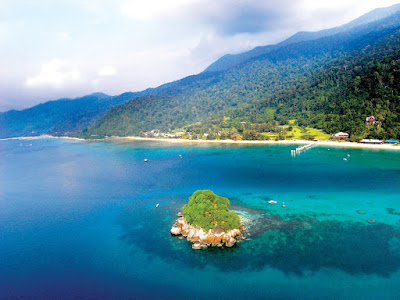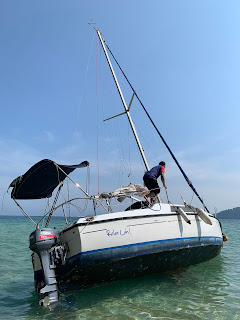 |
| Anchorages around the Islands |
 |
| Relax Lah! anchored off Pulau Harimau. P.Rawa in the distant background |
I guess it's about time that this blog entry is created. Considering Relax Lah and crew spend a reasonable amount of time around the islands Tioman, it is incumbent upon us to document anchorages in the area and approaches to them. If not us who else, right?
Although in reality there is no division, for our purpose lets divide these islands into two groups, the Tioman Group and the Pulau Tinggi group.
Tioman
The island has provided shelter to weary travellers for a millenium. No matter the direction of wind and swell, Tioman provides protection. There are three main anchor spots, around Tekek Bay, Juara Bay in the East and Mukut Bay in the South.
Relax Lah experience: This is our home base. Although we have a permanent place in the Marina, we have had occasions where we had to anchor out. Marina rennovations, or a day out snorkeling or late nights coming back from distance islands when the marina was full are some of the reasons for these.
4 Pulau Tulai West Sand/Rocks 2.9083735 N 104.1087659 E
 |
| Relax Lah! anchored off Tekek Bay, Tioman. Cabana Lodgings in the background |
 |
| Crew jumping off the bow at P.Tulai anchorage |
P.Seri Buat & P.Sembilang
These twin sisters are the closest islands West of Tioman. The gap in between them reach drying heights at low tide, and not passable on a boat. North and South of the channel it is possible to anchor in sand at a depth of around 10 meters before the deep drop offs. There is also a mangrove river that can be explored on a dingy in Pulau Sembilang.
Relax Lah experience: We have anchored and moored around Seri Buat a couple of times. We found that around these islands, the wind and swell come from different directions than we were expecting. On our first trip there en route from Tioman to Rawa during the south west season, we had anchored on the North side of the channel only to find out that the swell was from the north and we were not in the best spot to spend the night. Against our plans, we had to round the island to find a good protected spot in the South.
3 South of Sembilang Sand 10-12m 2.6797927N 103.9040423E
 |
| Relax Lah! crew mending engine frame off Seri Buat |
Pulau Rawa
Because the orientation of the island runs diagonal Northwest to Southeast, the countour does not shield boats from the Southerly or the Northeasterly, the two most common prevailing winds in the area. However, some mooring bouys are made available by the Rawa Island Resort for use by guests.
Relax Lah experience:
We visited Pulau Rawa twice and on both occasions took up the mooring bouy northeast of the Pulau Rawa Resort Jetty.
1 Rawa Anc/Mooring Sand 8-10m 2°31.005N 103°58.492E
 |
| Mooring off P.Rawa for some R&R |
Pulau (Babi) Besar, Tengah dan Hujung
Only P. Tengah and P. Besar has resorts and these are easily spotted around the jetties. You can see lights from the shores of Mersing from here. These string of islands are also a close hop from Pulau Rawa. The two north islands are connected by shallow reefs with a clearence less than 5m.
Relax Lah experience: Unable to find a suitable place to anchor near Rawa when we need protection from the wind and swell from the south, we rounded pulau Tengah and found a relatively calm spot between Tengah and Kecil to anchor overnight. The next day we picked up anchor and headed south to Besar. We found mooring bouys near the jetty, but with the impending storm decided to set anchor as a back-up.
# Description Holding Depth Lat Long
1 P.Besar West Anc Sand 10m 2°25.855N 1 03°58.494E
2 P.Tengah Sand 3-6 2°28.402N 103° 57.377E
Pulau Tinggi:
A 12 n miles hop from P Besar, Pulau Tinggi has been described as the triangle island because of the façade from afar. It is popular among divers and fishing folks. Two main anchorage areas. First in the south east part of the island between P. Tinggi and P. Simbang. The second spot in the south west of the coral reef in front of the beach – beautiful but only safe during quiet weather.
Relax Lah experience: We have not reached P. Tinggi yet!
# Description Holding Depth Lat Long
1 P. Tinggi North Anc Sand 11m 02° 19'.0 N 104° 06'.0 E
2 P.Tinggi SE Anc 10-15m Between P. Tinggi & Simbang
3 P.Tinggi SW Anc West of Coral reef by the beach
Pulau Sibu:
Being the most southerly island in the Mersing group, this island is popular among Singaporeans.There are restaurants and bars along the two long beaches in the east of the island. Possible to anchor in 12 m on a sand bottom, but be careful to not go to close to shore as a large band of coral is lying close to the beach.The south part of the island and P. Sibu Tengah are not accessible by sailing boat as it is full of coral patch.
Relax Lah experience: We have not reached Sibu yet!
# Description Holding Depth Lat Long
1 P.Sibu East Anc Sand 6m 02°13.3 104°04.3
2 P.Sibu West Anc Sand/Mud 4m 02°12.86 104°03.66
Pulau Pemanggil
Visible on the southeast horizion of P.Tioman is P.Pemanggil. Resorts and village on the north coast and the southern side is quite isolated. Only on Pemanggil one get to snorkel a wreck in 5 meters of water on low tide.
Relax Lah experience:
We passed by Pemanggil a couple of times, but anchored here only once. The isoloation of Telok Kandar is exquisite. After a few tries, we found a place to anchor in the sandy bay. Spent a good part of the afternoon climbing rocks on the cliff. The secluded by provided good protection from wind and tide overnight. Next morning we took our time to explore the wreck.
# Description Holding Depth Lat Long
1 Telok Kandar Anchoring 2.5788035 104.3291795
2 North Pemanggil Anchoring 2.5828009 104.3210064
 |
| Crew heading towards P.Pemanggil Teluk Kandar |
Pulau Aur
Approach from the west, either side of Pulau Lang, to anchor in 8-16 metres anywhere in the channel. This is the regional overnight spot providing good protection from north and south swells. The tidal flow through the channel can run up to two knots on springs. Fishing boats often raft-up in heavy weather. There are resorts on both side of the channel between Pulau Dayang and Pulau Aur. There are mooring bouys to be picked up near the village jetty.
Relax Lah experience: The 15hp outboard struggled with the strength of the current in the channel. It died two times. We took up a mooring bouy near the village. In hindsight, we should have set up anchor as added security.
# Description Holding Depth Lat Long
1 Bet P.Aur & P.Dayang 2°28.11N 104°30.13E
2 P.Aur East Anc 2°27.690N 103°31.643E
 |
| P. Aur pix taken from the Jetty. Relax Lah! took up a mooring bouy. |
 |
| Distance table |




















































